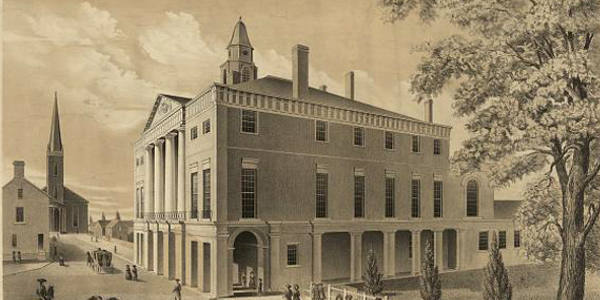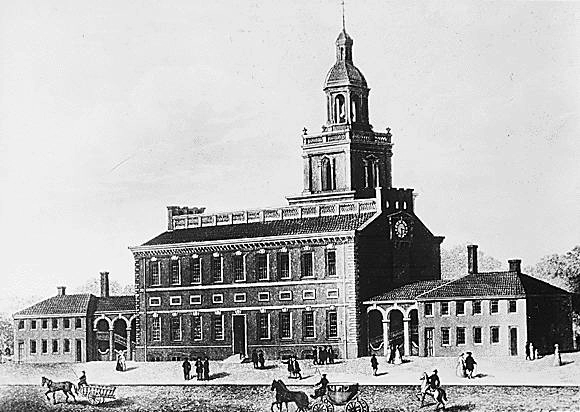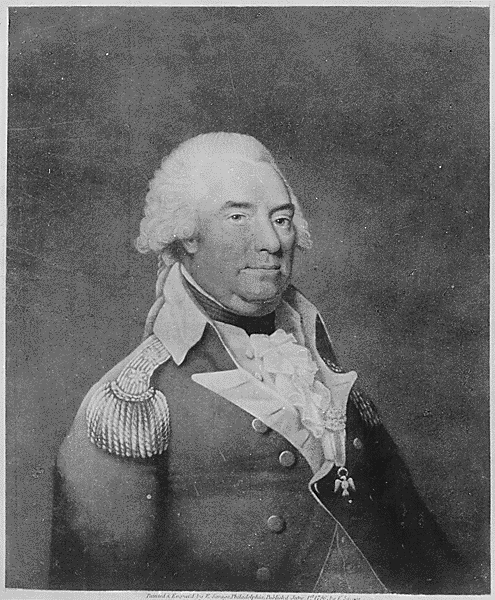Sponsor this page for $100 per year. Your banner or text
ad can fill the space above.
Click here to Sponsor the page and how to reserve your ad.
-
Timeline
1790 Detail
February 1, 1790 - The Supreme Court of the United States convenes for the initial session. Session is held for ten days at the Royal Exchange Building in New York City.

It had been decided, at first, that the Supreme Court would have six justices, including the Chief Justice. Yes, an even number that created the possibility of a tie. Washington named six nominees soon after the Federal Judiciary Act was signed into law. Two Supreme Court justices and ten federal court judges were actually named and approved only two days after the Federal Judiciary Act had been passed. All were in place before the end of 1789; John Rutledge of South Carolina, William Cushing of Massachusetts, James Wilson of Pennsylvania, John Blair Jr. of Virginia, and Robert Harrison of Maryland were appointed to serve as the Associate Justices. John Jay would act as the first Chief Justice. When Robert Harrison declined service, he was replaced by James Iredell (February 19, 1790). All were confirmed quickly by the Senate by October 19, 1789, except Iredell.
On February 2, 1790, the first session of the Supreme Court began. It would not be held in the same building that housed Congress, Federal Hall, but would take place not too far away in the Royal Exchange Building of New York City.

What Did the First Session Entail?
Supreme Court sessions were scheduled for twice per year, the first Monday of February and the first Monday of February. When only three of the first Supreme Court justices made it to the Royal Exchange Building on the appointed first Monday date, February 1, thus not giving the body a quorum, the initial session was pushed back one day, thus establishing February 2, 1790 as the first official date of a Supreme Court session. The duties of a Supreme Court justice at the start of the court was wide; beyond serving in the two sessions of the Supreme Court per year, they also served as district "circuit riding" justices at sessions around the nation, which met twice per year as well. Each justice was assigned to one of three geographical circuits.
When a quorum could not be reached on February 1, the gathered crowd in the chambers, including members of the New York Supreme Court, congressmen, the New York City mayor, and more, were disappointed. Jay, Cushing, and Wilson were in attendance. Rutledge, still mad about not being named Chief Justice, was holed up in his home in South Carolina. Some sources say that Rutledge was actually in New York City, but declined to attend. John Blair was in transit from Virginia. Harrison, who had been Washington's military secretary during the American Revolution, was not well and still debating whether to accept, preferring another job as Chancellor of Maryland. Washington confirmed Harrison's resignation within a week, thus Harrison effectively never served.
Once the court reached its quorum requirement on February 2, 1790, it began its first session with four justices (Jay, Cushing, Wilson, and Blair). The first session lasted until February 10, 1790. There were no cases on the docket for the first year, however, and the justices spent their sessions organizing the court. The first court case was brought before the Supreme Court on August 2, 1791. It was the case of West vs. Barnes, decided the next day. A previous case on the docket, Van Staphorst vs. Maryland, had been settled prior to oral arguments.
Despite its prestige today, an appointment to the Supreme Court was not considered as plum a position during the first decades of the United States government. The difficulties of providing services on the "riding circuit" with poor roads and travel conditions wore out some of the justices. John Jay resigned his post as the Chief Justice in 1795, preferring to be the Governor of New York. It was not until the John Marshall Court that tenure on the Supreme Court rose in length to the years we now associate. John Marshall, the 4th Chief Justice, served thirty-four years from 1801-1835.
So why did the first Supreme Court had six justices? We're not sure. It was included in Section One of the Federal Judiciary Act, one Chief Justice and five Associate Justices, thus federal law from the first session until later changed. It was almost certainly due to politics. The number fluctuated, changed by Congressional action from time to time, altered as the nation grew with additional judicial circuits (seven in 1807, nine in 1837, ten in 1863) until 1869 when the current total of nine was settled on. Does the Constitution state that they should have lifetime appointments? Yes and no. The clause referring to judges states that they should remain in office per "good behavior" and that has been construed since to mean lifetime appointments.
Buy Chronology

History of the Royal Exchange Building
The Royal Exchange Building was located on Broad Street, in lower Manhattan, near Water Street. It had been built in 1675 as a one story structure, a Merchants Exchange; an additional second story was added in 1752. The Chamber of Commerce of the City of New York used the second floor meeting room from 1770 until the Revolutionary War. The New York Legislature began meeting in the Royal Exchange Building in 1785. Its first federal judicial function had begun on November 3, 1789 when the District of New York federal court began its sessions. They moved to Federal Hall in 1791.
The Supreme Court held only two sessions at the Royal Exchange Building in New York City, the initial and a second in August. They moved, along with the rest of the Federal government, on December 6, 1790 to the new temporary capital, Philadelphia. Sessions were subsequently held at Independence Hall, then City Hall, before the federal government was moved permanently to Washington, D.C. ten years later in 1800.
The Royal Exchange Building, unlike Federal Hall, is no longer in existence today. It was demolished in 1799.
Image above: Drawing of the Royal Exchange Building, home to the first session of the Supreme Court in 1790, 1881, History of the City of New York by Martha Joanna Lamb. Courtesy Wikipedia Commons. Below: Engraving of Federal Hall, New York City, as it appeared in 1791, circa 1897, Cornelius Tiebout, Clay and Richmond. Courtesy Library of Congress. Info source: Mountvernon.org; "Takes: The Supreme Court's First Session," 2012, Jon Michaud, New Yorker; "Supreme Court Schedules First Session," 2012, Andrew Glass, Politico.com; supremecourt.gov; "Dates of Supreme Court Decisions and Arguments, United States Reports, Volumes 2-107 (1791-1882), 2018, Anne Ashore, Supreme Court Library; supremecourthistory.org; Library of Congress; constitutioncenter.org; Wikipedia Commons.

Back to Index







